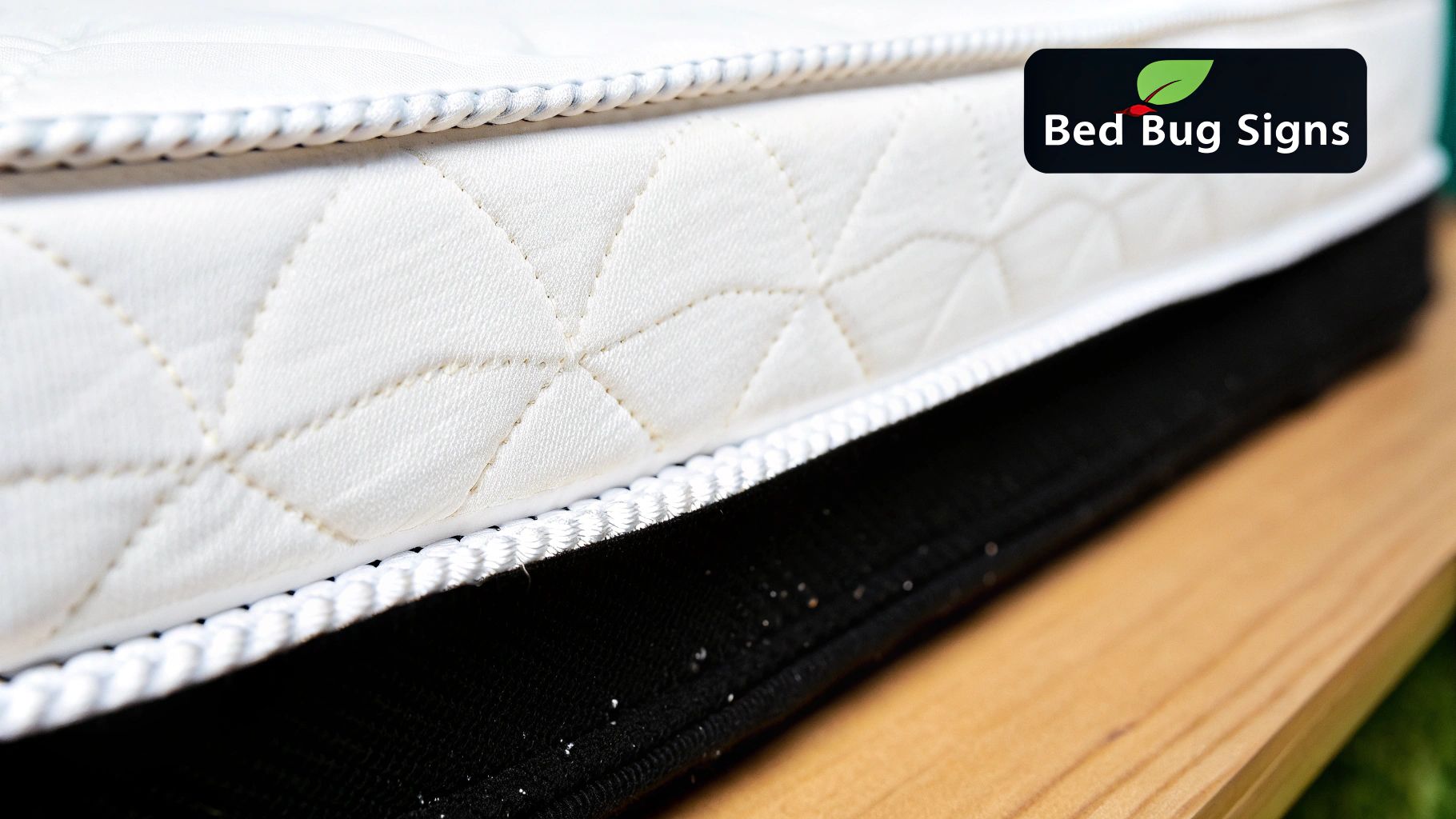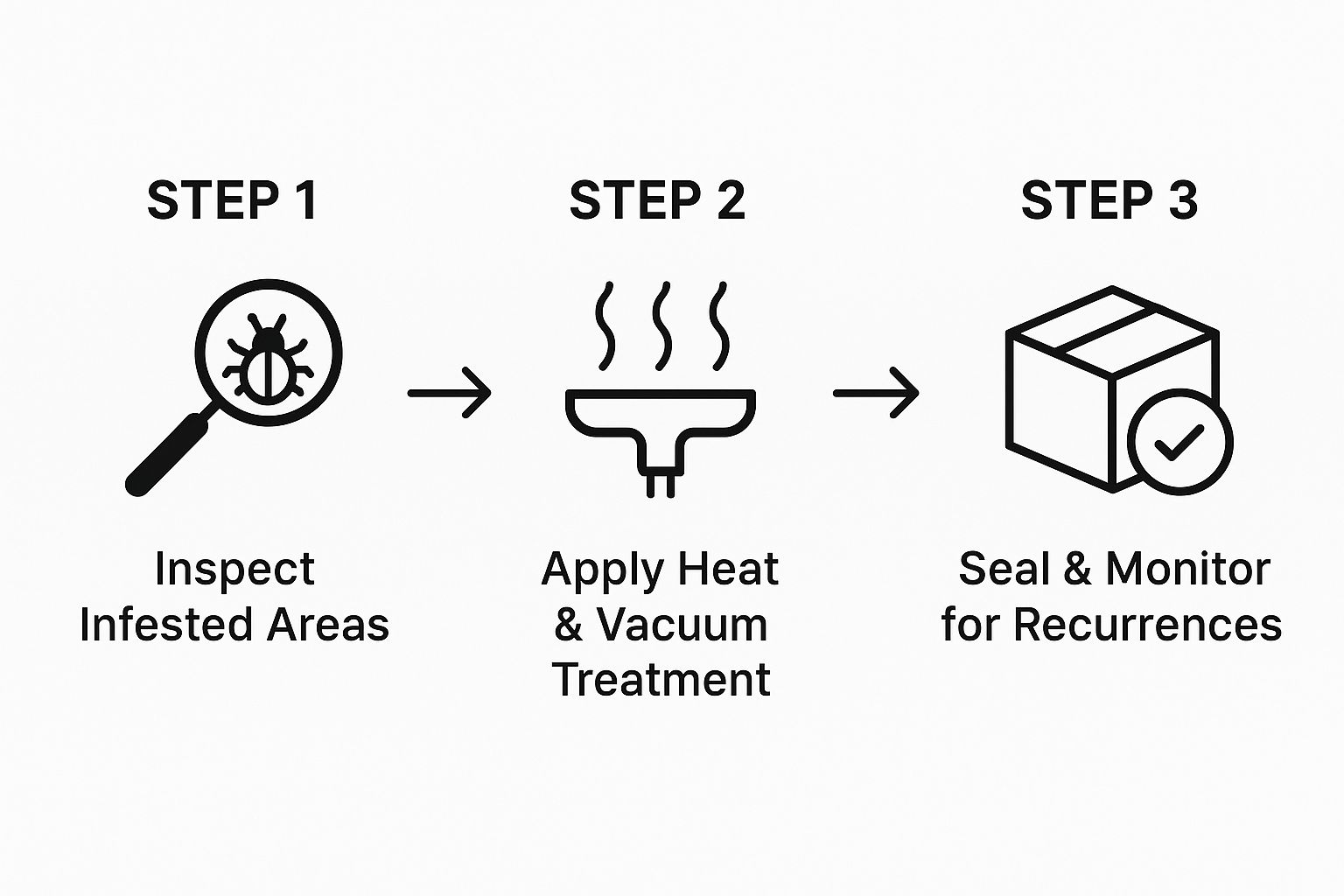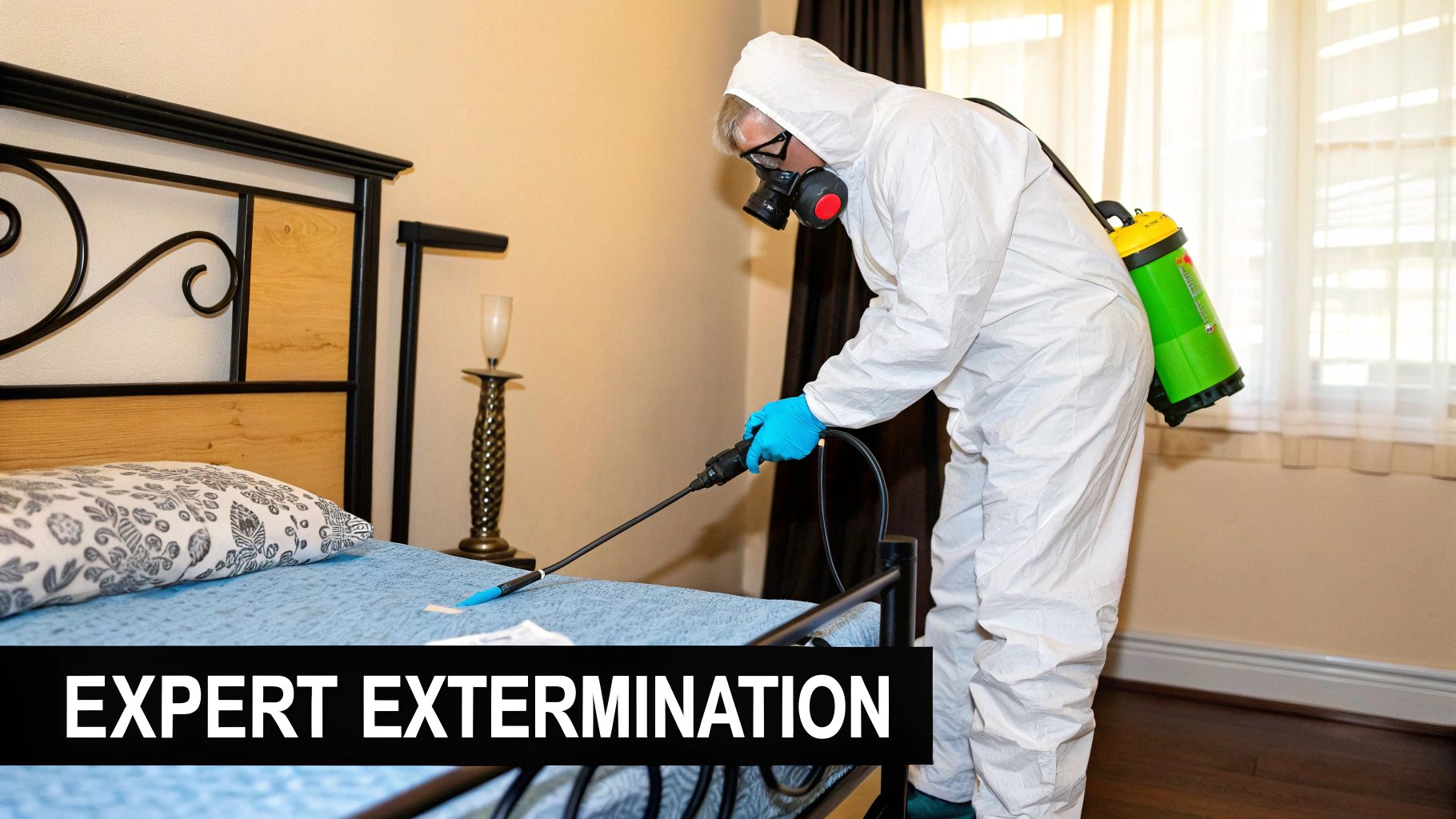If you’re dealing with a bed bug problem, you’re not alone. It’s a deeply frustrating and stressful situation that, unfortunately, many across the UK are now facing. To successfully get rid of them, you need a methodical, thorough plan that covers every angle—from inspection and prep to treatment and follow-up.
This guide gives you that exact eco-friendly process, step-by-step, so you can finally reclaim your home.
The Hard Reality of Bed Bug Infestations in the UK

Bed bugs have staged a major comeback across the UK, shifting from a pest we barely thought about to a common household nightmare. If it feels like you're hearing about them everywhere, it's because infestations are genuinely on the rise. This isn't just bad luck; it's driven by real-world factors that create the perfect storm for these pests to thrive.
One of the biggest culprits? The boom in global travel. As we move between countries, cities, and even just from one home to another, these tiny hitchhikers travel with us, tucked away in luggage, clothing, and second-hand furniture. Once they arrive, they don’t waste any time setting up a new home.
Urban Hotspots and How They Spread
Densely populated urban areas are ground zero for bed bug problems. Cities like London, with their high concentration of flats, hotels, and constant public transport, provide a perfect network for them to move from one property to the next.
It has nothing to do with cleanliness—it’s all about proximity and opportunity. An infestation in one flat can easily spread to its neighbours through walls, pipework, and shared hallways.
The numbers back this up. A British Pest Control Association (BPCA) survey from 2015/16 logged over 11,829 pest control call-outs for bed bugs. Back then, London was already being called the UK's bed bug capital, with cities like Leicester and Manchester not far behind. While things quietened down during the pandemic, the post-2022 travel rebound saw infestation levels in 2023 climb right back to where they were. You can find more data on UK bed bug prevalence and see just how widespread the issue has become.
The emotional and financial toll of an infestation is huge. The stress, sleepless nights, and constant worry can be overwhelming. On top of that, the cost of failed DIY treatments or ineffective services can quickly add up. Realising this is a shared challenge is the first step toward tackling it properly.
Understanding the Seasonal Risks
While bed bugs are a year-round issue, their activity definitely has seasonal peaks. We tend to see a surge in infestations during the late summer and early autumn. This is partly fuelled by summer holiday travel, which gives them more opportunities to spread. Warmer temperatures also help speed up their life cycle, allowing populations to grow much faster.
Being aware of these high-risk periods and locations is key to prevention. The table below breaks down the main risk factors.
UK Bed Bug Hotspots and Seasonal Trends
This table highlights key data on where and when bed bug infestations are most common in the UK, helping you understand regional and seasonal risks.
| Factor | High-Risk Indicator | Low-Risk Indicator |
|---|---|---|
| Location | Densely populated cities (e.g., London, Manchester) | Rural areas with detached housing |
| Housing Type | Multi-unit buildings (flats, terraces) | Standalone, single-family homes |
| Season | Late Summer & Autumn (August-October) | Winter (January-March) |
| Lifestyle | Frequent travel, use of public transport | Limited travel, less frequent visitor traffic |
This context is vital. It shows why a casual approach to bed bug treatment almost always fails. You aren't just fighting the bugs you can see; you're battling a resilient pest that is perfectly adapted to our modern way of life. That’s why a methodical, comprehensive plan—like the one in this guide—is your most reliable path to success.
Preparing Your Home for Treatment Success
I’ve seen it countless times: a client has the best eco-friendly products on the market, but the treatment fails. Why? Because a successful bed bug treatment is 90% preparation. If your products can’t reach the hidden bugs and their eggs, you’re just wasting time and money, and the infestation will inevitably rebound.
Think of this prep phase as your chance to turn the tables on these pests. You're systematically exposing their hideouts and creating a clear battlefield. Skipping these steps is the single biggest mistake people make in DIY pest control. It’s like trying to paint a room without cleaning the walls first – the effort you put in now directly translates into better, faster results.
Declutter and Create Clear Zones
Bed bugs absolutely thrive in clutter. Piles of clothes, stacks of books, and overstuffed cupboards are five-star hotels for them. Your first mission is to methodically take away these hiding spots, but you have to do it carefully to avoid spreading the problem.
Work room by room. Grab some heavy-duty plastic bags and, as you sort items, immediately bag anything you plan to keep, treat, or throw away. Seal these bags tightly before you move them anywhere. This containment is non-negotiable.
For instance, never carry a loose pile of clothes from an infested bedroom to the washing machine. You're just giving bugs a free ride. Bag them securely in the bedroom first. This one small action prevents a stray bug or egg from dropping off and starting a new colony in your hallway.
The Power of Heat and High-Temperature Washing
Heat is a bed bug’s greatest enemy. A sustained temperature of 49°C (120°F) is lethal to both adult bugs and their surprisingly resilient eggs. This makes your washing machine and tumble dryer two of your most powerful weapons in this fight.
Gather up every washable fabric from the infested areas. This means everything:
- Bedding, pillows, and even the duvet itself.
- All clothing from drawers and wardrobes, even items you think are clean.
- Curtains, soft toys, and fabric cushion covers.
- Rugs and bath mats if they are machine washable.
Wash everything on the highest heat setting the fabric can safely handle. Afterwards, tumble dry on high heat for at least 30 minutes. It's the intense, dry heat of the dryer that really finishes the job. Once clean and treated, place the items into fresh, new plastic bags and seal them up. Don’t bring them back into the room until the entire treatment is finished.
Expert Tip: For delicate items that can't handle a hot wash, the tumble dryer can still be your friend. A 30-minute cycle on high heat can often kill bed bugs without the damage a hot wash might cause. Just be sure to check the care label first.
The Art of Strategic Vacuuming
Your vacuum cleaner is more than just for cleaning; it's a tool for targeted removal. The goal here is to physically suck up as many live bugs and their eggs as you can find. Use a vacuum with a crevice tool to get into all the nooks and crannies where these pests love to hide.
Focus your efforts with surgical precision. Go slowly and be thorough.
- The Mattress: Pay close attention to the seams, tufts, and the piping that runs along the edges.
- The Bed Frame: Systematically vacuum every joint, screw hole, and crack in the headboard and frame. Don't miss a single spot.
- Surrounding Furniture: Empty out and vacuum bedside tables, chests of drawers, and wardrobes inside and out.
- The Room's Perimeter: Run the crevice tool along all skirting boards, especially in the corners and where the board meets the wall.
- Upholstery: If you have sofas or chairs in the room, remove the cushions and vacuum deep into the crevices underneath.
Once you’re done, this next step is critical. Take the vacuum cleaner outside immediately. Remove the bag, seal it inside another plastic bag, and throw it away in an outdoor bin. If you have a bagless model, empty the canister into a sealable bag outdoors, then wash the canister thoroughly with hot, soapy water. This ensures no captured bugs can crawl back out and into your home.
This level of detail is what separates a failed attempt from a successful bed bug treatment plan.
Eco-Friendly Bed Bug Treatment Methods That Work
With your home prepped and ready, it's time to get down to the business of treatment. This is where we bring in the principles of Integrated Pest Management (IPM), a smart strategy that relies on a combination of non-chemical methods to hit the infestation from every angle. This approach isn't just safer for your family and pets; it’s often more effective in the long run, especially as we see more cases of chemical-resistant bed bugs.
The core of our eco-friendly plan hinges on a powerful trio: targeted heat from a professional steamer, the dehydrating power of diatomaceous earth, and the simple but brilliant barrier of a mattress encasement. Each one has a specific job to do in breaking the bed bug life cycle.
This graphic gives a great overview of how these eco-friendly steps flow together, from the initial attack to long-term monitoring.

As you can see, success isn't about one magic bullet. It's about a systematic process that combines a direct assault with clever, long-term prevention.
Harnessing the Lethal Power of Steam
Steam is your number one weapon for immediate, on-contact kills. When used correctly, high-temperature steam gets deep into fabrics and crevices, destroying both adult bugs and their notoriously tough eggs.
But not just any steamer will cut it. You need a model that produces a consistent, low-moisture 'dry' steam at a temperature of at least 82°C (180°F) right at the tip. Anything less, and you’re just giving the bugs a warm, steamy bath.
The key is to move the steamer nozzle slowly—about one inch per second—across every single surface.
- Mattress and Box Spring: Go over every inch, paying extra attention to the seams, tufts, and folds where bugs love to hide.
- Bed Frame and Headboard: Methodically treat all the joints, cracks, and even the screw holes. If your headboard is fixed to the wall, steam the gap behind it.
- Furniture: Don't forget nearby sofas, upholstered chairs, and the inside of drawers.
Your goal here is to apply that lethal heat to every potential hiding spot you found during your inspection. It’s a slow, painstaking process, but it’s absolutely vital for knocking down the active population right away.
Applying Diatomaceous Earth Correctly
Once the steam treatment is done, it's time for the next layer of defence: food-grade diatomaceous earth (DE). This isn't a poison. It's a fine powder made from fossilised algae. Under a microscope, you'd see it's made of tiny, sharp particles that act like shards of glass. These scratch the waxy outer shell of a bed bug's exoskeleton, causing it to dehydrate and die.
Application is everything with DE. You want a very fine, almost invisible dusting, not thick piles of powder.
- Use a small puffer or duster bottle to get a light, controlled application.
- Apply a thin layer in places where bugs are forced to walk through it.
- Focus on areas like behind skirting boards, inside electrical outlet covers (switch the power off first!), and along the joints of the bed frame.
A common mistake I see is people applying way too much DE. Bed bugs are clever enough to just walk around a big pile of powder. The most effective application is a light dusting they won't even realise they're crawling through.
While steam kills on contact, DE provides lasting, residual protection. It lies in wait to kill any bugs that crawl out from deep hiding spots or hatch from eggs you might have missed in the days and weeks to come.
The Final Step: Sealing the Deal with Encasements
With the steaming and dusting complete, the final protective step is to install certified bed bug-proof encasements on your mattress and box spring. These zippered covers are non-negotiable and serve two critical functions.
First, they trap any surviving bugs or eggs inside the mattress. With no way to get out and feed, they will eventually starve and die.
Second, they create a smooth, impenetrable barrier that gets rid of all the seams and folds bed bugs use for hiding. This makes future inspections much, much easier, effectively taking the mattress out of the equation as a harbourage area. Just make sure you get a high-quality encasement specifically tested for bed bugs—a standard mattress protector won't do the job.
This kind of thoroughness is more important than ever. Bed bug infestations are becoming a major issue across the nation. Between 2022 and 2024, the UK saw a shocking 35% increase in bed bug problems. This surge is putting a real strain on public resources, with the average council spending over £125,000 on pest control. For individuals, a single call-out can cost anywhere from £10 to £283, showing just how much of a financial burden these pests can be.
If you're dealing with a complex situation, like an infestation that has spread or involves other pests like cockroaches, a professional service is your best bet. You can explore our expert solutions for combined bed bug and cockroach treatment to see how integrated strategies work for even the toughest challenges.
Remember, a successful bed bug treatment is a marathon, not a sprint. It takes patience, diligence, and a multi-pronged attack to truly get your home back.
Knowing When to Call a Pest Control Professional

While the eco-friendly methods we've covered are surprisingly effective, there comes a point where even the most dedicated DIY effort just won't cut it. Admitting you need help isn’t a sign of failure; it's a strategic move to reclaim your home for good. Some bed bug battles are simply too big or too complex to fight alone, and knowing when to call in the experts can save you months of stress and wasted money.
One of the biggest red flags is when the infestation has clearly spread beyond a single room. Maybe you first found them in the main bedroom, but now you’re seeing tell-tale signs on the living room sofa or, worse, in your child's room. At this point, the problem has likely established multiple footholds. A room-by-room DIY approach becomes a frustrating game of whack-a-mole; you’ll knock them back in one area, only for them to thrive in another.
Another clear sign is when the problem just keeps coming back. You’ve done everything right—laundered all the bedding, steamed every crevice, and applied diatomaceous earth with military precision. Yet, a few weeks later, the bites and spots reappear. This usually means you’ve missed the main harbourage area, or the bugs are hiding somewhere your tools can't reach, like deep inside wall cavities or behind fixed headboards.
Identifying Unwinnable Situations
Sometimes, the sheer scale of the problem is obvious from the get-go. If you pull back your sheets and can easily see dozens of bugs scattered across the mattress, you’re looking at a deeply entrenched, multi-generational infestation. This isn't a job for a handheld steamer.
These scenarios demand specialised equipment that simply isn’t available to the public. Take professional heat treatment, for instance. This method raises the temperature of an entire room to a lethal level, penetrating every last crack to kill bugs and their eggs in a single session. It's a level of thoroughness that DIY methods can't hope to match.
Look out for these clear indicators that it's time to call in the professionals:
- Multiple Rooms Affected: You're finding evidence of bugs in more than one room.
- Failed DIY Attempts: The infestation returns no matter what you try.
- Hidden Source: You see the signs but can't find where they're nesting.
- High-Clutter Environment: There are too many belongings to realistically inspect and treat yourself.
- Severe Health Reactions: Someone in the home is having a strong allergic reaction to the bites.
The stress and anxiety from a persistent bed bug problem can be overwhelming. Calling a professional isn't just about killing pests; it's about getting your peace of mind back and knowing the job will be done properly.
Choosing a Reputable UK Pest Controller
Once you’ve decided to get professional help for your bed bug treatment, picking the right company is crucial. Not all pest controllers have the same level of expertise, and bed bugs are notoriously one of the toughest pests to eradicate.
Start by looking for companies that are members of a recognised trade body like the British Pest Control Association (BPCA). This is a good sign they adhere to professional standards. Always ask about their specific experience with bed bugs and the treatment methods they favour. A good firm will happily walk you through their process, whether it’s heat, targeted insecticides, or an integrated approach.
In a major city like London, professional help is often essential. In boroughs like Islington and Tower Hamlets, population density can exceed 3,600 people per square mile, making it incredibly easy for infestations to pass from one property to another. It's no surprise that the capital consistently sees the most call-outs in the UK for bed bugs.
Before you agree to anything, ask for a detailed quote and a clear plan of action. A reputable company will insist on a thorough inspection before recommending a treatment. This ensures you're investing your money wisely with a partner who can finally bring your bed bug nightmare to an end.
How To Stop Bed Bugs Coming Back

Getting rid of bed bugs is a huge relief, but the job isn't truly done until you've secured your home against their return. After all the stress and effort of a successful bed bug treatment, the last thing anyone wants is a repeat performance. The key is to switch from reactive panic to proactive prevention.
This just means developing a few new habits that become a normal part of your routine. It's about being smart, not scared. A few simple, consistent actions can offer lasting peace of mind and make sure your home stays a no-go zone for these pests.
Make Regular Inspections a Habit
Your best defence is an early warning system. Bed bugs are far easier to handle when you catch them early, long before a few stray bugs can multiply into a full-blown infestation. We always advise clients to commit to a quick but thorough check of high-risk areas at least once a month.
So, what does that look like in practice?
When you change your bed sheets, just take an extra five minutes. Check the mattress seams, behind the headboard, and along the bed frame itself. Shine a torch into the joints and along skirting boards near the bed. You’re looking for the classic signs: tiny black spots (their faecal matter), translucent shed skins, or, of course, a live bug.
This regular check-up turns what sounds like a chore into a quick, manageable task. It’s a tiny investment of time that pays huge dividends in security.
Deploy Interceptor Traps as Your Sentinels
Interceptor traps are a brilliantly simple invention for ongoing monitoring. These are small plastic dishes you place under each leg of your bed. The outer wall is textured so bugs can climb in, but the inner well is too smooth and slippery for them to escape.
They serve two crucial purposes:
- Early Detection: They work as a passive monitor. If a lone bug tries to climb onto your bed, it gets caught, giving you immediate proof that a new problem is brewing.
- A Physical Barrier: They create an obstacle, making it much harder for bugs crawling from the floor to reach you while you sleep.
Placing these under your bed legs and checking them weekly is one of the most effective and low-effort prevention tactics you can use. They are your silent guardians, on duty 24/7.
Think of interceptors as a smoke alarm for bed bugs. You hope you never need them, but you’ll be incredibly glad they’re there if you do. They transform monitoring from an active hunt into a passive catch.
Adopt Smart Travel Habits
Travel is, without a doubt, the number one way bed bugs get into a clean home. Whether you're in a five-star hotel or a budget hostel, you have to assume bed bugs could be present. A few pre-emptive checks can stop you from bringing home the worst kind of souvenir.
The moment you enter a hotel room, don't put your suitcase on the bed or floor. Use a hard surface, like the luggage rack (after checking it!) or even in the bathroom. Before unpacking, pull back the sheets and inspect the mattress seams and headboard. This five-minute check is non-negotiable.
When you get back home, don't bring your suitcase into the bedroom. Unpack it in a garage, utility room, or the bathtub. Put all your clothes directly into a plastic bag and take them straight to the washing machine for a hot wash and dry cycle. Vacuum your suitcase thoroughly, inside and out, before storing it away.
While these tips offer excellent personal protection, sometimes a situation requires a broader strategy. If you manage multiple properties or face complex pest issues, exploring professional pest control services can provide a more robust, long-term prevention plan. It’s about creating a comprehensive shield for your entire property, not just a single room.
Your Bed Bug Treatment Questions, Answered
When you're facing a bed bug problem, a million questions can race through your mind. It's a stressful situation, and even with a solid plan, it's natural to have doubts. We get asked these questions all the time, so we've put together some straightforward answers based on our real-world experience.
How Long Does a Complete Bed Bug Treatment Actually Take?
This is the big one, and the honest answer is: it depends. The timeline really hinges on how severe the infestation is and which treatment route you take.
A professional heat treatment, for example, can often get the job done in a single day—that's its major selling point. But if you’re sticking to the eco-friendly approach we've outlined, you need to be ready for a longer haul. The first, intense phase of decluttering, washing everything, vacuuming, steaming, and applying dusts can easily consume a full weekend.
But you can't stop there. Bed bug eggs are incredibly tough and can hatch up to two weeks after being laid. This means you need to stay on high alert for at least two to four weeks after your big clean-out. You’ll be monitoring for any signs of new activity and reapplying treatments to catch any freshly hatched nymphs before they have a chance to grow up and start the cycle all over again.
Patience isn't just a virtue here; it's a core part of the strategy. A hasty job almost always leads to a comeback.
Are Eco-Friendly Treatments as Effective as Chemical Ones?
Yes, they absolutely can be, but there's a catch: their success is entirely down to how thorough you are.
Eco-friendly methods like high-heat steam and diatomaceous earth don't rely on chemical poisons. They work through physical force. Steam literally cooks bugs and their eggs on contact, while diatomaceous earth is a fine dust that scratches their waxy outer layer, causing them to dehydrate and die.
Their effectiveness is 100% dependent on meticulous application. You have to be patient, making sure your steam penetrates every possible crevice and that your dust is applied as a fine, almost invisible layer, not in thick clumps. It's a common myth that chemicals are automatically the "stronger" option. In reality, bed bug resistance to common pesticides is a huge and growing problem. An integrated, eco-friendly strategy often works better in the long run because bugs can't build up a resistance to being cooked or physically destroyed.
Do I Really Need to Throw Away My Mattress?
In most cases, the answer is a firm no. Tossing your mattress is not only an expensive and wasteful reaction, but it can also make the problem worse by spreading bed bugs through your building as you carry it out.
If your mattress is in decent shape without any major rips or holes, it's almost always salvageable. Here's how:
- Start by thoroughly vacuuming every single seam, button, and fold. Get right in there.
- Next, use a high-temperature steamer, moving slowly and methodically across the entire surface.
- Finally—and this is the most crucial step—seal it inside a certified bed bug-proof mattress encasement.
This encasement acts as a tomb for any survivors, who will eventually starve, and it creates an impenetrable barrier preventing any new bugs from getting in. The only time we'd suggest getting rid of a mattress is if it's already old, heavily torn, and provides too many deep hiding spots to treat with any real confidence.
Can Bed Bugs Live in Places Other Than My Bed?
Absolutely. Thinking the problem is confined to the bed is one of the biggest mistakes people make.
While the bed is prime real estate—it gives them easy access to their food source (you)—they are resourceful survivors. As an infestation grows, the bed gets crowded, and they'll branch out to find new, undisturbed hiding places.
A proper inspection has to go far beyond the mattress. Bed bugs are masters of concealment and love tight, dark spaces. Make sure you inspect and treat all these common hotspots:
- Along and behind skirting boards
- In the joints and screw holes of the bed frame and other furniture
- Behind picture frames and under any peeling wallpaper
- Inside electrical outlet covers and light switches
- Within the seams and folds of sofas and chairs
- Even in the spines of books on a nearby shelf
Remember, a successful treatment is a comprehensive one. Assuming the problem is only in your bed is the fastest way to find yourself dealing with it all over again in a few weeks.
Dealing with a persistent pest problem requires a detailed, evidence-based approach. At Pest Predators Limited, we combine biological expertise with practical solutions to offer effective, long-term relief from pests like bed bugs. If you need professional support to reclaim your home, learn more about our pest control services in the UK.
Article created using Outrank



